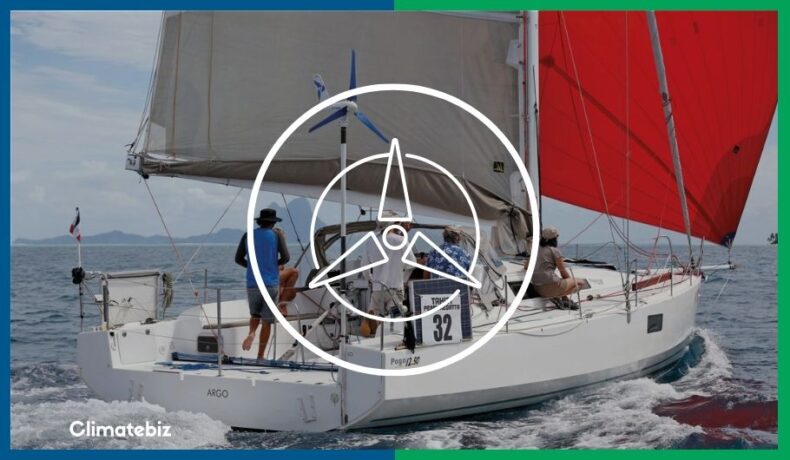If you’re a sailor or boat owner, you know how important it is to keep your batteries charged. But did you know that you can use sustainable energy to power your boat? In fact, you can harness the wind’s kinetic energy with wind turbines for boats.
Humans have been harnessing the wind for thousands of years. Early seafarers have used this wind to power their boats, getting as far as Australia!
But with modern technology, you can now use this kinetic energy to power your boat’s batteries!
We cover everything you need to know in this guide on wind turbines for boats. We look at the type of turbine you need, calculate the required energy, and the costs involved.
Table of Contents
Can A Wind Turbine Power A Boat?
With advances in alternative power technology, boats have started taking advantage of solar and wind energy.
By installing a small turbine onto your vessel, you’ll be able to charge your batteries as long as there’s wind.
However, this doesn’t mean you’ll be able to power your whole boat. Sure, you’ll be able to harness some kinetic energy from the wind, it might not be enough.
There are a lot of appliances and crucial instruments on board that need power.
Ideally, wind turbines can power your average sailboat boat, but a couple of factors could affect this.
Some of these influences are:
- The wind resources available in your cruising area: windspeeds along a coastline differ from windspeeds on a lake.
- Turbine placement: the higher you mount a turbine on a boat, the more electricity it’ll generate.
- How often you use your boat: you’re more likely to experience higher wind speeds while sailing than in the harbor.
Regardless, a wind turbine for boats is handy to install, even if it’s just for that extra boost.
What Size Wind Turbine Does My Boat Need?
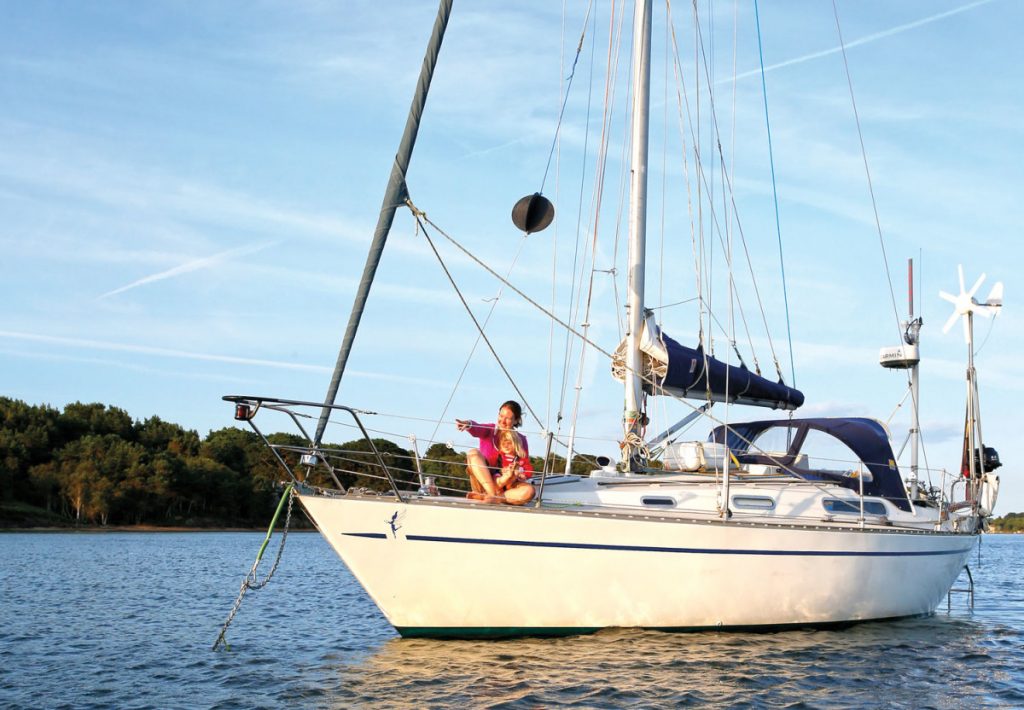
Source: Sail Magazine
Your energy requirements will determine the size of your boat’s wind turbine.
For example, if you’re going for a fun and relaxed trip, you’ll only need power for your electronics. Conversely, if you’re going fishing or trolling, you’ll need a more extensive battery system.
Understanding The Math Of Wind Turbines For Boats
Calculating a power turbine’s energy output can be a little confusing; let’s go through the math to understand everything better.
This formula works out each electronics power demand and, ultimately, your boat’s power demand.
Power (W) = Voltage (V) x Current (A)
Runtime
The next thing to remember is that each device has a runtime — while the device is running, it uses power (watts). The number of watts something uses in an hour is called watt-hours. For example, an appliance rated 500 W will use 500 Wh of energy in an hour.
The same appliance rated 500 W will use 1000 Wh in two hours — this is the same as 1 kilowatt.
Amperes
Amperes – or amps for short – is a unit of measurement of electric current. They’re also used to indicate the capacity of your battery.
Energy (Wh) = Voltage (V) x Capacity (Amp-hours or Ah)
For example, a 12 V, 100 Ah battery will give you 1200Wh
Wh = 12V x 100Ah ∴ Wh = 1200
That means your battery can give off 1.2 kW of energy per hour.
How Much Power Does Your Boat Use?
The size of your battery will determine what size your wind turbine you’ll need. For example, a wind turbine that generates 400 watts can charge an 800 Ah battery for a day on a 12-volt system.
The average 45-foot sailing boat uses 150 amp-hours per day. However, your battery bank needs to be at least double or triple the size, so it doesn’t deplete. For example, a 450 Ah capacity battery in a 12V system would require 5.4 kWh per day. Can a wind turbine generate that much power?
As we’ll see later in this article, the average wind turbine has a max of 0.42 kWh. So on paper, that’s 10 kWh per day. However, in reality, it’s much different.
You see, the 0.42kWh is only guaranteed when you’re facing 20-knot winds all the time. Unfortunately, that’s not possible – at least for most of us.
In fact, according to Betz law, your wind turbine will only generate 59% of its actual capacity. Taking that into account, let’s see if a 420 W wind turbine will still power our example boat:
0.59 x 10 kWh = 5.9 kWh
That’s just over the amount your battery can handle.
Which Boat Wind Turbine Is Suitable For You?
To determine which turbine is suitable for you, you’ll have to calculate the power demand of your boat. You’ll multiply the amps per device by its runtime to do this. For example, Autopilot uses 4 amps, and you use it for 12 hours — that’s 48 Ah.
Based on this seafarer’s measurements, here’s a general look at how much power a vessel uses:
| Device | Daytime Ah | Nighttime Ah |
|---|---|---|
| Autopilot | 48 | 48 |
| Cabin Light | 0 | 1.8 |
| GPS | 9.6 | 9.6 |
| Cockpit Instruments | 3.6 | 3.6 |
| Deck Lights | 0 | 1.7 |
| DB Board & DCM | 1.2 | 1.2 |
| Freshwater pump | 4 | 4 |
| Fridge | 24 | 24 |
| Gas alarm | 7.2 | 7.2 |
| SSB | 37 | 12 |
| VHF | 4.2 | 4.2 |
| TOTAL | 138.8 | 117.3 |
If this sounds right for your boat, you’ll need 138.8 Ah during the day and 117.3 Ah at night — that’s around 256.1 Ah per day.
Additionally, we’ll need to know the kWh to determine the turbine size. Using the calculation above, we can calculate that the required energy is 3073.2 Wh which is 3.07 kWh.
To ensure that your battery doesn’t deplete, let’s double the required energy, which now equals 6.14 kWh.
In conclusion, you’ll need a turbine that generates 6.14 kWh per day.
How Much Can The Average Wind Turbines For Boats Generate?
Due to external factors, your turbine will only generate 59% of its capacity. For instance, the average turbine can produce 0.42 kW at 20-knot winds. However, it’s more likely that your average recreational sailboat will experience 12-knot winds.
At 12 knots, the average turbine generates 53 watts, equal to 1.2 Kwh per day. Unfortunately, 59% of that is only 0.75 kWh. That’s nowhere near the required amount.
Perhaps you’ll find that this amount of energy will power your boat. If not, hopefully, it can at least power your fridge, GPS, lights, and freshwater pump.
How Much Do Boat Wind Turbines Cost?

Source: primuswindpower
That was a lot to get through, but the hard part is over.
Now that you know your turbine requirements’ wattage, you can start looking at prices.
Off the bat, the average turbine will cost $1446 and can generate a maximum of 885 watts. But, of course, this is the maximum wattage, and you’re unlikely to reach this capacity.
Here’s a table of turbines that compares the wattage to price:
| Wattage | Average Price | Price/watt |
|---|---|---|
| 300 | 650 | $2.16 |
| 400 | $1,750 | $4.3 |
| 600 | $1,150 | $1.92 |
| 1500 | $2,520 | $1.68 |
| 2000 | $2,590 | $1.29 |
Surprisingly, the most cost-efficient turbines are the ones with higher wattage. Therefore, you can say that forking out the extra money for a higher wattage turbine is worth the investment.
Where Is The Best Place To Install A Wind Turbine On A Boat?
Wind turbines for boats are most efficient when facing directly into the wind. Any swaying or rocking will cause the turbine to turn away from the wind, decreasing efficiency. As such, it’s best to place the turbine near sea level or above the cockpit.
The Higher It’s Placed
Did you know that placing the turbine higher will increase its production rate? In fact, setting the turbine on the masthead can increase its efficiency by 50%. However, putting the heavy machinery that high can disrupt your vessel’s stability.
In addition, the pendulum effect of the boat is more intense at that height, decreasing the turbine’s efficiency.
Near Cockpit Level
However, placing the turbine just above the cockpit is a good option and here’s why:
- Having the turbine above the cockpit allows for easy access, making maintenance easier.
- While the wind speeds are slower at this level, the turbine will be more stable.
- The distance between the turbine and the battery bank is smaller. This means you can run smaller cables between the two.
- You won’t have to worry about voltage drop due to the short transfer distance.
The Downside
Having a spinning rotor and blades near you can be dangerous, especially in high winds. Just keep an eye out for the ‘sweep’ area of the blades and ensure the turbine is positioned high enough.
How Much kWh Can A Boat Wind Turbine Produce?
‘How much’ is always tricky as multiple factors are involved. For instance, there are different wind speeds according to where you sail. However, most manufacturers say that their turbines have a max of 0.42kWh.
To understand this better, let’s look at three different turbine models and compare their stats.
Silentwind
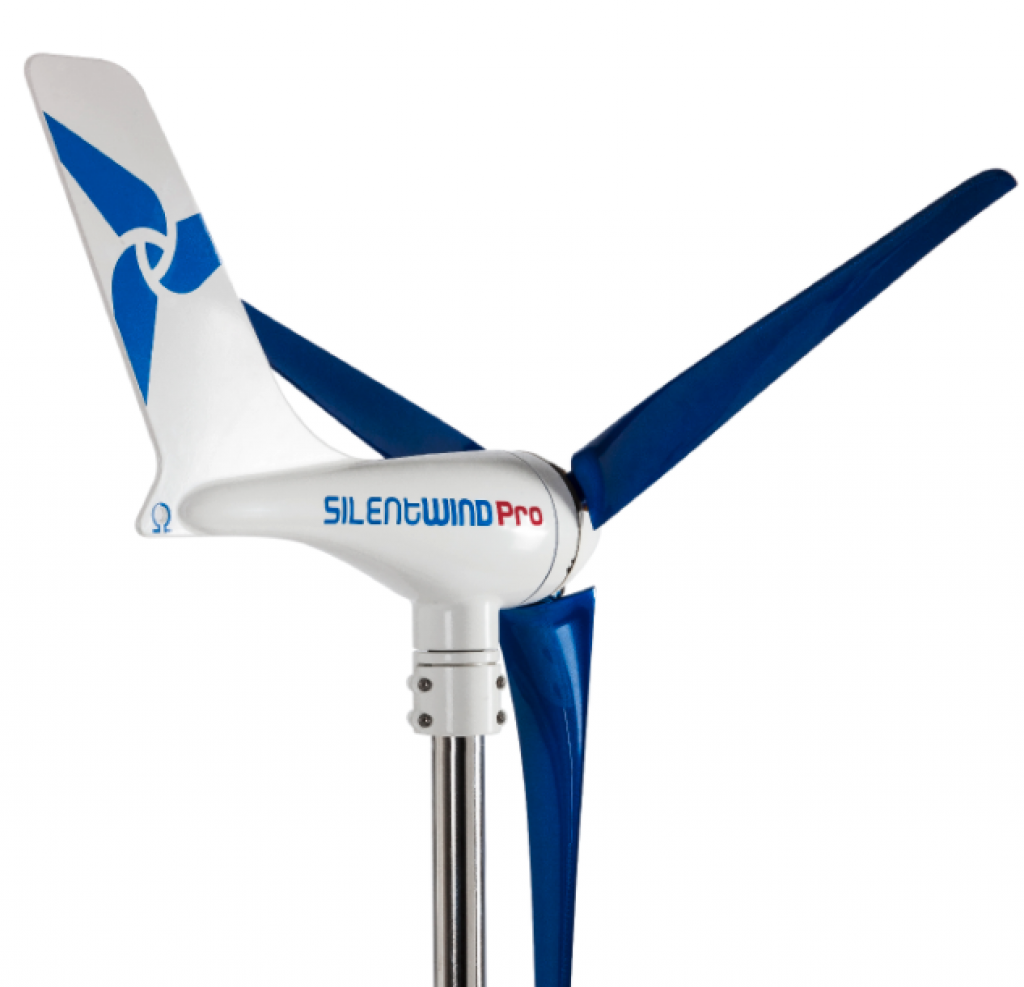
The Silentwind turbine has a maximum output of 420w at a wind speed of 25 knots (28 mph). However, most boats will only experience a max of 20 kt (23 mph). At this wind speed, Silentwind can generate up to 140w.
In addition, the turbine has a cut-in speed of 6.2 kt. (7 mph). However, common wind conditions of 12 kt. (13.8 mph) will generate 45w.
The Silentwind turbine sells for $2,069 with the option of a mast-connector kit for $420.
Rutland 914i Windcharger
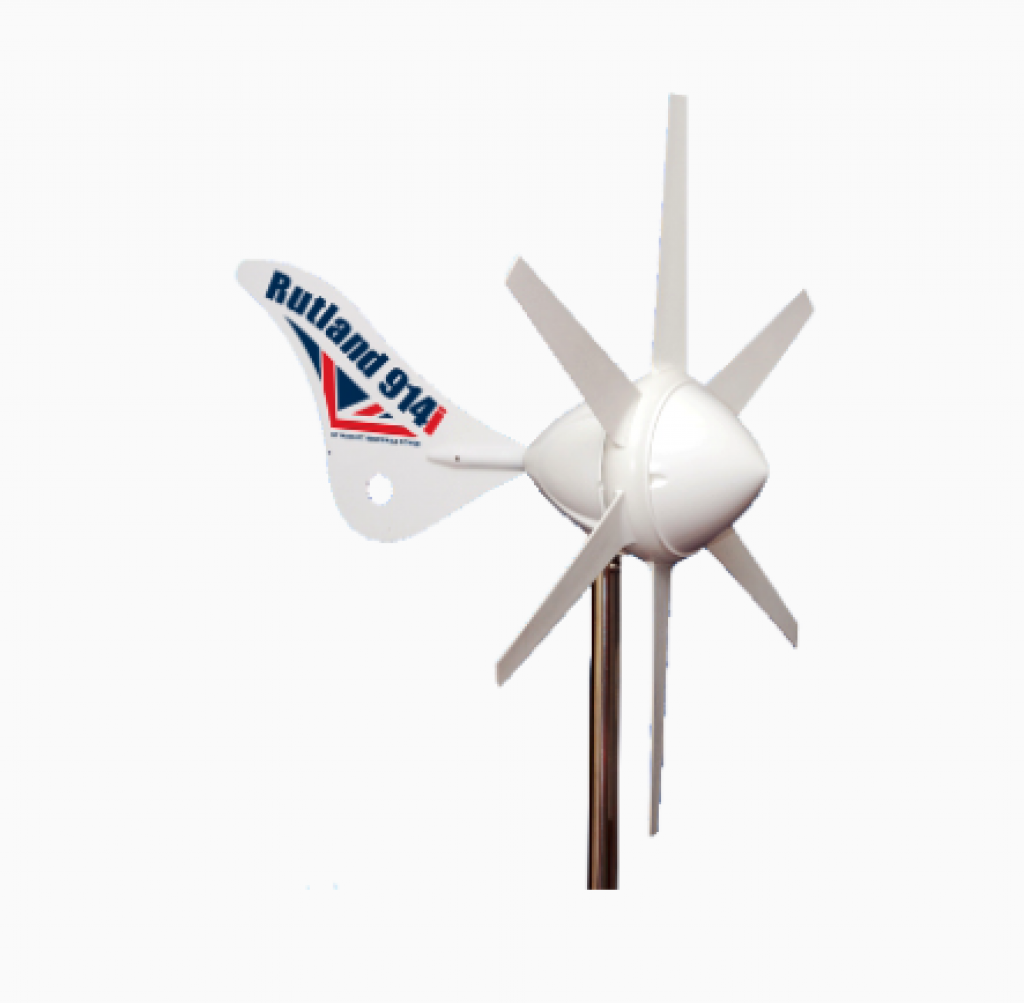
The Rutland promises a 30% efficiency increase due to its maximum power point tracking (MPPT). It has a maximum output of 450w at a wind speed of 28 kt (32 mph) and a cut-in speed of 4 kt (4.6 mph)
At 20 knots wind, it generates 255w, and at 12 knots, it drops down to 60w. You can buy the Rutland for $729.95 and view its brochure here.
Nature Power wind generator
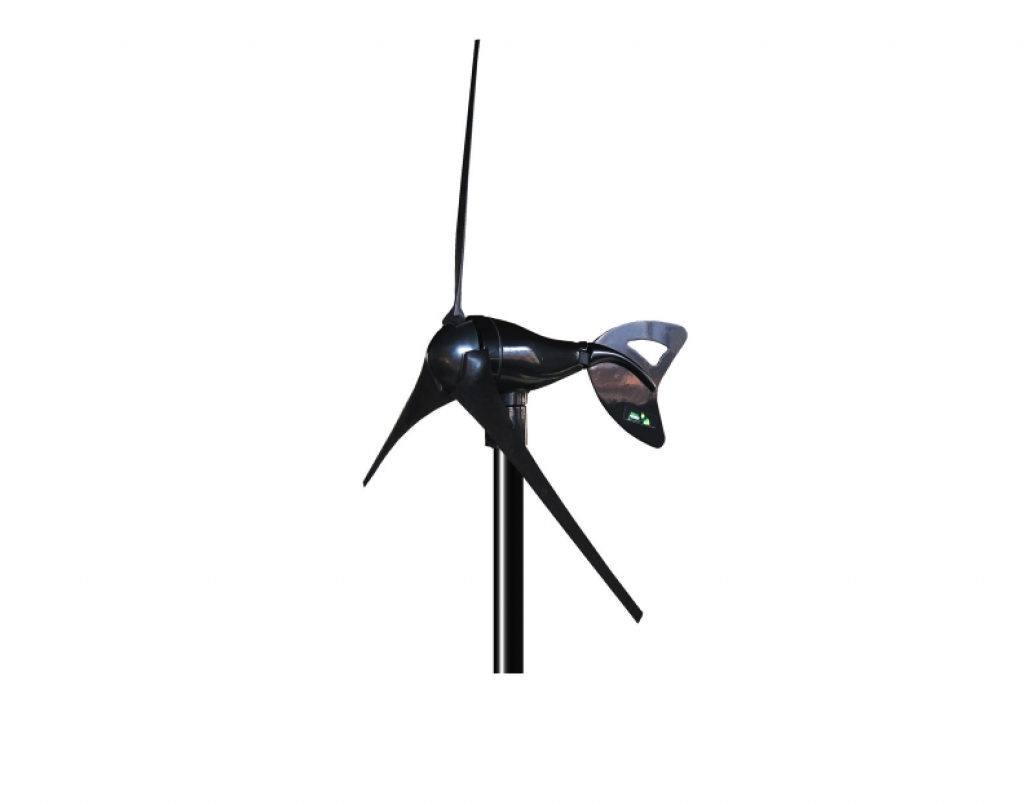
Nature Power offers a turbine that generates 500w, making it a good option for larger boats. It has a maximum wind speed of 24 kt (27 mph) and a 6.1 kt (7 mph) cut-in speed.
Additionally, it ranges from 55w to 280w between 12 kt and 20 kt wind speeds.
The turbine goes for $534 and includes an internal MPPT regulator.
Comparison Table Of Wind Turbines For Boats
Let’s put those in a table to compare the figures. Something to keep in mind is that 400w is about 800 amp-hours per day on a 12V system.
| Silentwind | Rutland | Nature Power | Average | |
|---|---|---|---|---|
| Maximum watts at 12v | 420 | 450 | 400 | 420 watts |
| Maximum wind (knots) | 25 | 28 | 24 | 25 knots |
| Output (w) at 20-knot wind | 140 | 255 | 280 | 225 watts |
| Output (w) at 12-knot wind | 45 | 60 | 55 | 53 watts |
| Cut-in speed (knots) | 6.2 | 4 | 6.1 | 5.4 knots |
Are Wind Turbines Better Than Solar Panels On A Boat?
Wind turbines and solar panels are great options to install on a boat. However, which is better? Their price and efficiency can determine this.
Cost Comparisons Between Solar Panels And Wind Turbines For Boats
When comparing costs, the number of watts generated is vital. For example, a solar panel might generate the same wattage as two turbines.
You’ll have to do some research and calculations to determine your boat’s energy needs. By doing so, you can calculate how many solar panels/wind turbines you would need.
In addition, the price of solar panels and wind turbines will depend on your location. But, a quick comparison puts wind turbines for boats in a higher price bracket than solar panels.
Solar Panels cost anywhere between $400 and $1200. In contrast, most wind turbines fall in an $1100 to $1800 price bracket.
Efficiency Comparison
Both solar panels and wind turbines come with their advantages and disadvantages. These affect the efficiency and energy output of your boat.
The most significant difference is that solar panels won’t generate power at night or on cloudy days. On the other hand, wind turbines can generate power 24/7. In addition, since they have low cut-in speeds, the turbines will continuously generate power as long as there’s wind.
However, solar panels have a lifespan of 25 years, while wind turbines for boats only last 20 years. It’s also important to note that solar panels don’t need a lot of maintenance, whereas wind turbines do.
Lastly, solar panels tend to generate more power than wind turbines. Depending on your sailing needs, you might prefer solar panels to wind turbines or vice versa. So at the end of the day, the choice is yours.
Final Thoughts
And there you have it, a complete guide to wind turbines for boats!
We’ve looked at calculating the energy requirements of your boat and how to match that with turbines. Additionally, we compared different turbine costs and kW outputs. Lastly, we looked at three different types of marine turbines which you can use.
In conclusion, wind turbines are exceptionally efficient for smaller sailboats or recreational boats. However, wind turbines can also work if you have a larger boat and are just looking for an extra boost.
We suggest a hybrid solar panels and wind turbines system for larger boats with high energy demands.
If you have any questions or want to share your projects, we encourage you to join our community!

